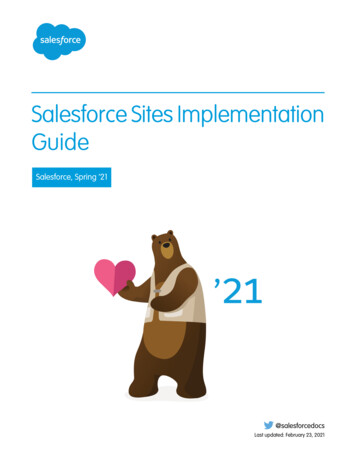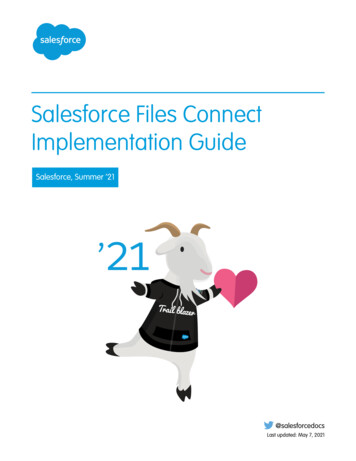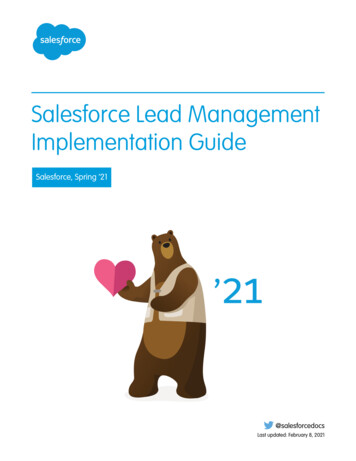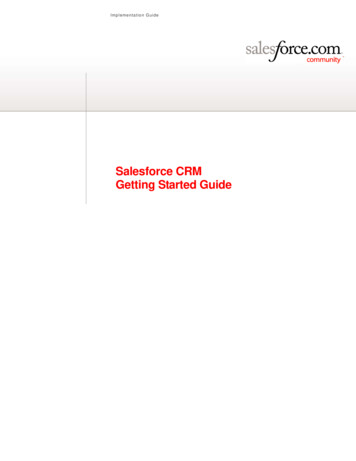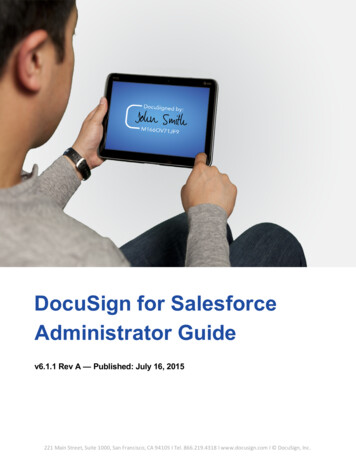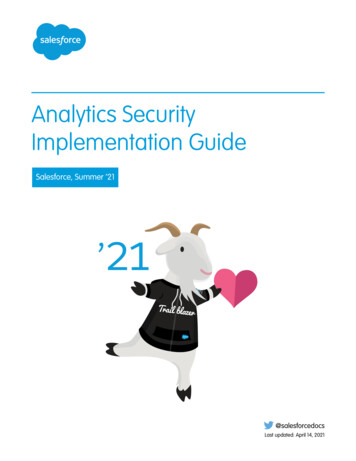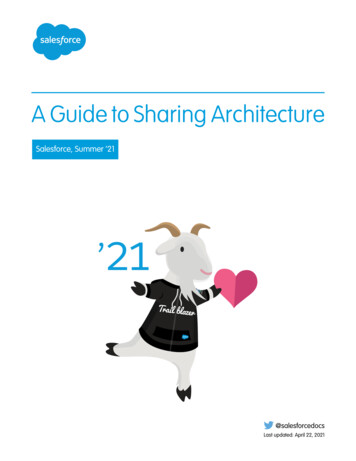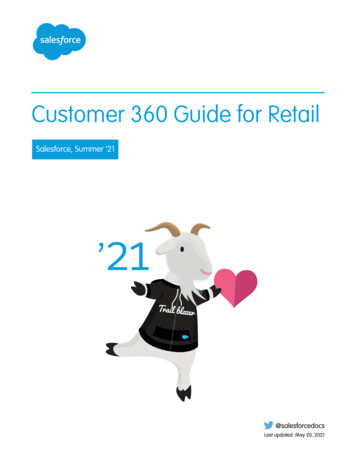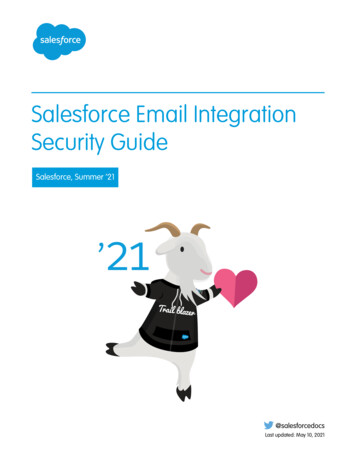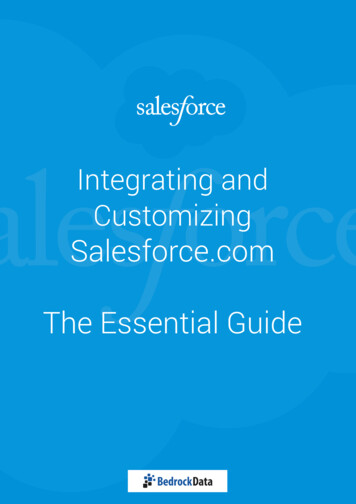
Transcription
Integrating andCustomizingSalesforce.comThe Essential Guide1
BEDROCK’S GUIDE TO SALESFORCE.COMINTRODUCTIONWhat’s in this Guide?Ease of Use and System Design: How easy is the system to use for your company’susers? What are the best features of this system, how do they work and what can theydo for your team?The Data Model: How are Salesforce’s objects setup? How will data flow between those objects?Customization: Mainly we will look at custom fields and custom objects in Salesforce,as well as layouts. Everyone needs the almighty lead object, but after you’vesuccessfully implemented the standard Salesforce objects, what else can you create torepresent your business?Automation: Automation refers specifically to lead assignment and workflow rules.We’ll review these capabilities in Salesforce and focus on ease of use of thesefeatures.Integration and APIs: How easy are Salesforce’s APIs to use? Are there available integrations for the system and will it be easy to incorporate existing product and businessdata into the system?Pricing and Scalability: We’ll review the pricing and editions that Salesforce offers,including the flexibility you get and the pros and cons of certain editions.Mobile: Short review of available mobile applications that exist, developed by the company themselves or by a third party. Focused on iOS and Android apps only.Overall: Bottom line: how good of a system is this for your business.2
BEDROCK’S GUIDE TO SALESFORCE.COMINTRODUCTIONIntroduction to SalesForce.comSalesforce.com (“SFDC”) is the leader in today’s massive cloud based CRM market.In fact in a recent study, 45% of companies with up to 1000 employees report usingSalesforce.com, with Dynamics CRM and Oracle in second and third respectively.SFDC is the leader for a reason: they were the first CRM company to focus primarily oncloud based infrastructure for their software, and first movers advantage seems to haveworked out very well for the San Francisco company. They are also the most powerfulCRM among other competitors, having taken a platform approach to their software fromearly on. Salesforce has a large part of their development team working on the platformpiece, where they produce APIs that allows internal and external app developers to writeapps on top of.This approach has enabled SFDC to give their users not only the ability to vastly customizethe system to suit their business, but also to enable independent developers to write appson top of SFDC and sell those apps in the Apple App Store-like AppExchange.There’s no doubt that SFDC is a powerful product that seems attractive. The question youmust answer is whether SFDC is the right CRM for your business. The answer will probablybe influenced by cost, company size and feature need.Let’s dive a little deeper.3
BEDROCK’S GUIDE TO SALESFORCE.COMEASE OF USEEase of Use and System DesignSalesforce has essentially the same high level design as other CRM’s: their leadmanagement setup looks like other CRMs (Lead Contact, Opportunity, Account).Because of the ease of SFDC’s customization capabilities, the typical SFDC implementationhas some custom objects built into it and configured, which play into a customer’s lead andcustomer management workflow in the system.For example, if you are a software as a service business (as we are), you may want to havea custom object that represents a “subscription.” Or perhaps you’re a consulting companythat’s using SFDC – in which case you may want to build and configure a custom object torepresent a consulting engagement.Integration between objects (both standard and custom objects) in Salesforce is critical.Much of the time, this needs to be handled by SFDC APEX code, which is the product’s ownJava-oriented scripting language that gets tested and deployed within SFDC.For example, if you have a contact record in SFDC, and a change to a field value on thatcontact should update the parent account record, a simple workflow in SFDC will not makethis happen – you will need to write code to accommodate this.Unfortunately, this means that fully implementing SFDC at your company could becomequite costly, should many customizations need to be made. It’s not a cheap or easy systemto implement.4
THE ESSENTIAL CRM BUYER’S GUIDE6. SalesForce.comThe SalesForce.com Data ModelSales records start as Leads in Salesforce. Leads arepeople and are sales leads, either qualified orun-qualified and can be associated with Campaigns.Leads are assigned to sales reps via automatedAssignment Rules. If qualified, leads are thenconverted into Contacts and associated with anAccount.Accounts are companies in most cases.Opportunities, which represent “deals,” or piecesof business are also associated with Accounts,and therefore have contacts linked to them as well.A “closed/won” deal is used to mark a customerSalesforce.com gets more powerful when you createCustom Objects to represent the different aspects ofyour business. These objects can be related to otherobjects in the system and customized.5
BEDROCK’S GUIDE TO SALESFORCE.COMIMPLEMENTATIONImplementantion and CustomizationCustom FieldsLayoutsSalesforce.com makes it easy to createcustom fields of various types. They dolimit the amount of custom fields that youcan create in the system however, which ispart of their pricing structure. Somethingto be wary of in your purchasing process.SFDC layouts are easy to change andmanipulate to suit the fields that you’d liketo display to your users. Interestingly, theSalesforce platform also includes layoutsthat you can create on your own: literallyyour own custom HTML/CSS/JavaScriptthat you can place in layout elements onthe page. This part of Salesforce is calledVisualForce, read more about it here.Custom ObjectsAPEX CodeCustom objects are a big part of SFDCfor most companies. You can easilycreate custom objects in SFDC, and setupautomation between those custom objectsand other object data through workflowsor custom code.APEX is SFDC’s proprietary scriptinglanguage that allows for deepcustomization of your SFDC instance.You can use APEX to manipulate databetween different objects in SFDC, createnew records or edit existing recordsautomatically.6
BEDROCK’S GUIDE TO SALESFORCE.COMAUTOMATIONAutomationSalesforce.com automation features allow you to setup rules that assign leads andmanipulate data within an object.Lead Assignment - Users and QueuesLead assignment in Salesforce is used toassign lead records to users. A lead assignment rule looks at a specific set of criteria ona lead and if the criteria evaluates to “true”(based on a formula or a set of rules), thenthat lead will get assigned to either a user ora queue. A queue in SFDC is a separate datastructure that “owns” records. When a recordis assigned to a queue, a workflow or APEXcode can assign it to a user. For instance, if alead isn’t initially qualified, you can assign itto a queue first, then if they become qualified,you can re-assign them to a user at that time.WorkflowsSFDC workflows are similar to workflow rules that you may have used in othersystems. Each workflow rule consists of criteria that cause the workflow rule to runand immediate actions that execute when a record matches the criteria. For example,SFDC can automatically send an email that notifies the account team when a newhigh-value opportunity is created. Workflows can also have time-dependent actionsthat queue when a record matches the criteria, and execute according to timetriggers. Workflows only work within a single object (like an account or opportunity)or on a child objects like tasks.7
BEDROCK’S GUIDE TO SALESFORCE.COMAPEXX Notes on APEXMore APEX: Develop and DeployThe workflow for Salesforce’s APEX development framework is similar to other“Build Test Deploy” development frameworks. SFDC does maintain that your code passat least xx% of code coverage in order to be deployed, essentially protecting you fromyourself.SFDC Enterprise instances also come with sandbox instances that you can use to deploythe code to initially, test it and then deploy to your production instance once you’re contentwith the functionality.APEX TriggersAPEX triggers are bits of code that you can configure to be executed at certain times, suchas: insert, update, delete, merge and upsert. For instance, you can have a bit of code thatwill change a field/value on an acocunt record “after update” on a contact record. Triggersare powerful ways to modify and manipulate data in the system, and take workflows to awhole new level.8
BEDROCK’S GUIDE TO SALESFORCE.COMINTEGRATIONIntegrations, APIs and AppExchangeMany Salesforce integrations are available through third party integration providers likeBedrock Data, as well as on the Salesforce AppExchange, which is the (self proclaimed)world’s leading business app marketplace. There are many integrations on the AppExchange already, along with other apps that may be able to help your company. It’s worth having alook at the marketplace to see if any may help your company with your usage of SFDC.For integrations or your own internal use, SFDC also provides API access for customers onthe Enterprise and Unlimited editions of the product. There are a few different APIs that maybe useful to your team, including a REST API that allow you to work with JSON or XML, aswell as a SOAP API that returns XML data.9
BEDROCK’S GUIDE TO SALESFORCE.COMPRICINGPricing and ScalabilityThere’s no doubt that Salesforce is a very scalable system – in fact it can really scale justabout as large as your company will get, especially with the amount of customizations available to you in the Salesforce platform.The drawback with it is in its pricing – it’s not cheap. Plans start at 25/user/month for theGroup edition, but to get workflow, automation and APEX access to really customize andscale the platform, you’re going to have to go with the Enterprise edition, which is 125/user/month.Here’s a pricing breakdown:SALESFORCEGROUP PLANSALESFORCEPROFESSIONALPLANSALESFORCEENTERPRISE PLANSALESFORCEUNLIMITED PLANBase featuressupported. Includinglead management,Chatter and CasesCampaign support(does not includemarketing cloud),dashboards, rolesWorkflows, APEX codesupport, full sandboxes,history trackingPretty much unlimitedeverything, including24/7 support 25 65 125 250user/monthuser/monthuser/monthuser/monthAs a comparison, Salesforce.com is essentially the priciest system out there for what youget. Notably, it’s also the most powerful.10
BEDROCK’S GUIDE TO SALESFORCE.COMMOBILESalesForce1 Mobile AppSalesforce made news last year at their massive Dreamforce conference in San Franciscowith the release of Salesforce1.With the announcement of Salesforce1 comes improved APIs and AppExchange, and also anew mobile app, which was a long time coming for SFCD customers.The app itself has mostly good reviews in the iPhone and Android marketplaces:A P P S T O R E S R AT I N G SIPHONE3 . 5 / 5 S TA R SANDROID3 . 7 / 5 S TA R SThe app gives you basic control over yourSalesforce data: create, edit and delete records, and also lets you switch betweenaccounts with ease.You can access Salesforce apps that you’veinstalled in the mobile app as well – andeverything can be administered from yourSetup area in Salesforce.com.A big step forward for the company in termsof their mobile strategy, but nothing mindblowing here. Salesforce1 is a useable,adequate mobile app that will likely improveover time (we’re bullish on it).11
BEDROCK’S GUIDE TO SALESFORCE.COMOVERALLOverall TakeawaysSalesforce.com is a great product - there’s a reasonit’s considered the leader in the CRM space today.It has the features and flexibility to fit virtually any business, small or enterprise alike. Youcan also scale exceptionally well with Salesforce as your company grows.The issues that we find are mainly based around costs to achieve that scale and growthwith the product. The brilliance of Salesforce is perhaps their business model (based arounduser seats), combined with the features that enable more than sales people touse the product. At many companies, support teams, consultants and accountmanagers will also use SFDC, alongside sales team members.These added users will drive up your costs considerably. For instance, if you have asales team of 30 reps, a support team of 10 reps and 20 other account managers andconsultants, those 60 users at the Enterprise edition are going to cost you upwards of 100,000 per year and that doesn’t factor in implementation costs.We’re not here to complain about the price of Salesforce.com however. We actuallyrecommend it to companies who can afford it and want to grow quickly. If you’re in thatcategory, our advice is to not mess around with the Group or Professional editions, and goright to Enterprise - it’s simply not worth the money when there are other, cheaper systemsout there with the same functionality (Zoho, Sugar and Dynamics CRM).12
In ConclusionHopefully we’ve provided you with helpful information that you can use to make educateddecisions about implementing, customizitng and integrating Salesforce.com. Should youhave any questions about anything that may not have been covered in this guide, feel freeto contact us at any time. We will be more than happy to get you started.Easily Integrate Your Business DataYou can use Bedrock to sync between yourcloud business systems and keep a running backupof your critical business dataTRY BEDROCK FOR FREEOr, Schedule a DemoBedrock Data is a data management platform that allows businesses to synchronize andmanage their data quickly and easily.Bedrock connect to a lot of different bussiness systems, including CRMs, ERPs, MarketingEmail, Suppot, Finance and E-commerce systems. Connect with us to learn more, or justget started with an integration today.745 AtlanticAve. Street3rd Floor Boston,02111 1-877-588-2671 sales@bedrockdata.com www.bedrockdata.com186 South Boston,MA. MA.02111 1-877-588-2671 sales@bedrockdata.com www.be
cloud based infrastructure for their software, and first movers advantage seems to have worked out very well for the San Francisco company. They are also the most powerful CRM among other competitors, having taken a platform approach to their software from early on. Salesforce has a large part of their development team working on the platform piece, where they produce APIs that allows internal .


